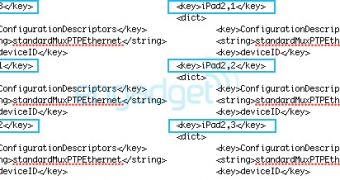Further digging in Apple’s iOS 4.3 code has cropped up references to multiple, unconfirmed iOS devices, including three new iPads, and two new-generation iPhones. The latter group is rumored to emerge this Summer, lacking the physical Home button.
Those who’ve been quick to get their hands on the latest iOS IPSWs and SDK from Apple have been able to confirm the existence of new iOS devices.
New designations include an iPhone 3,3, three new iPad models (iPad 2,1; iPad 2,2; and iPad 2,3), and two major new iterations of the iPhone - iPhone 4,1 and iPhone 4,2, which are believed to emerge as the GSM and CDMA variants of an all new iPhone this summer.
To ensure everyone gets the big picture, we feel compelled to inform readers that Apple’s first generation iPad carries a model number of "iPad1,1" while the AT&T (GSM) iPhone 4 carries the "iPhone3,1" model number.
The newly-confirmed, Verizon (CDMA) iPhone 4 carries a model number of iPhone 3,2 - therefore iPhone 3,3 is also new.
The second-generation iPad is also expected to land on both Verizon’s and AT&T’s networks, therefore at least two of the three, newly-referenced models are somewhat explained.
iOS 4.3 is known to add 4 or 5 finger multi-touch gestures on the iPad.
It is worth pointing out that sources talking to the Boy Genius Report are telling the website that “the reason Apple just added multitouch gestures for the iPad in the latest iOS 4.3 beta is because the iPad will be losing the home button.”
According to these presumably reliable source, “Instead of button taps, you will use new multitouch gestures to navigate to the home screen and also to launch the app switcher,” the site, which has a solid track record of accurate predictions, informs.
Interestingly, neither BGR, nor any secondary sources reporting on this tidbit speculate that Apple could be planning the removal of the physical Home button in order to open up more space for the devices’ screens.

 14 DAY TRIAL //
14 DAY TRIAL //